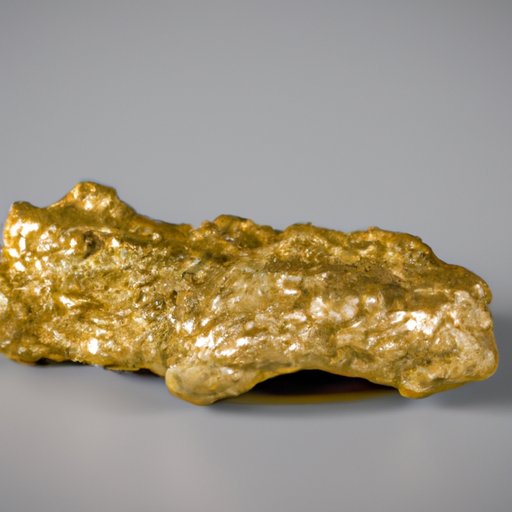Introduction
A gold nugget is a naturally occurring piece of native gold. It is often found in nature in watercourses or in soil deposits. Gold nuggets can range in size from tiny grains to large rocks weighing several pounds. The term “nugget” refers to any piece of gold that has been naturally shaped by erosion or weathering processes.
This article will explore the physical and chemical properties of a gold nugget, how it is formed, the process of mining for it, and its benefits and rarity. It will also examine its value in relation to supply and demand.
Exploring the Physical Properties of a Gold Nugget
A gold nugget is typically yellow in color, but can also occur in shades of white, red, or orange. They are usually rounded or angular in shape, although some may be flat. The size of a gold nugget varies greatly, from small flakes to large rocks that can weigh several pounds.

How a Gold Nugget is Formed
Gold nuggets are formed over time through geological processes such as weathering and erosion. Gold is typically found in rock formations, where it is exposed to the elements. Over time, the rock erodes away and the gold is left behind. This process can take thousands or even millions of years, depending on the conditions.
Gold can also be found in sedimentary deposits, which are formed when rivers carry gold particles downstream and they settle into the riverbed. These particles eventually become concentrated in certain areas, forming a deposit of gold-bearing sediment.

The Chemistry Behind a Gold Nugget
Gold nuggets are composed mainly of gold, but may contain other elements such as silver, copper, and iron. Depending on their origin, some nuggets may contain trace amounts of other elements such as arsenic, antimony, and lead. These impurities can affect the color, hardness, and malleability of the nugget.
Mining for Gold Nuggets
There are two main methods of mining for gold nuggets: placer mining and hard rock mining. Placer mining involves panning or dredging for gold along streambeds or in riverbanks. This method is used to locate deposits of gold-bearing sediment. Hard rock mining involves drilling and blasting to access veins of gold-bearing ore in underground mines.
Uses and Benefits of a Gold Nugget
Gold nuggets have a variety of uses and benefits. They are often used to make jewelry, coins, and other decorative items. Gold is also a popular investment option due to its rarity and high value. Gold nuggets are also used in electronics, dentistry, and other industrial applications.

The Rarity and Value of a Gold Nugget
The value of a gold nugget depends on its size, purity, and rarity. The market price of gold fluctuates with the supply and demand of the metal. As the demand for gold increases, so does its value. Gold nuggets are considered rare and valuable due to their limited supply.
Conclusion
Gold nuggets are pieces of native gold that are formed through geological processes. They vary in size, shape, and color, and may contain other elements such as silver, copper, and iron. Gold nuggets are mined using placer and hard rock mining methods, and are used in jewelry, coins, electronics, and dentistry. They are considered rare and valuable due to their limited supply and the fluctuating price of gold.
In conclusion, a gold nugget is a mineral due to its composition and formation process. It is also a valuable and sought-after commodity due to its rarity and use in various industries.
(Note: Is this article not meeting your expectations? Do you have knowledge or insights to share? Unlock new opportunities and expand your reach by joining our authors team. Click Registration to join us and share your expertise with our readers.)
